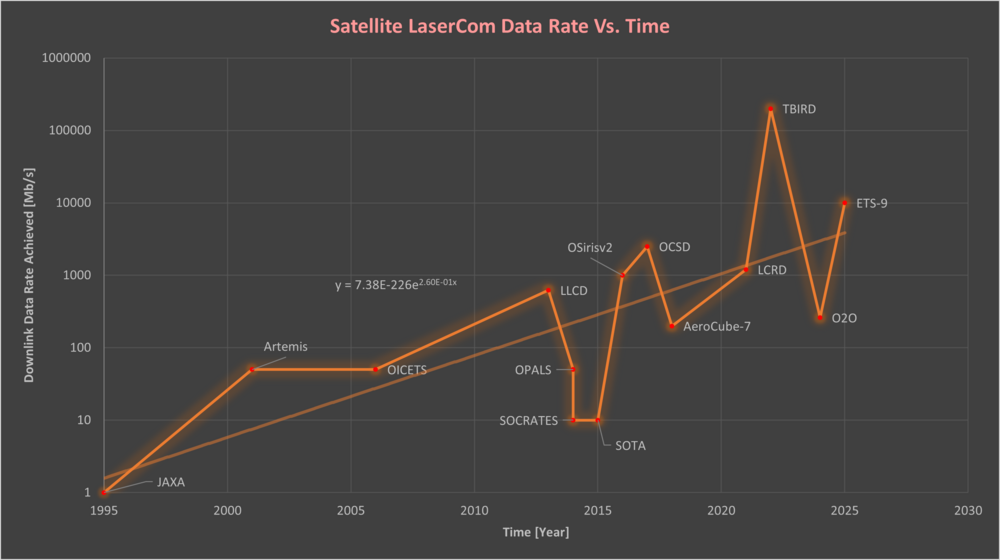Satellite Lasercom
Technology Roadmap Sections
Roadmap Overview
Satellite Laser Communication (LaserCom) is a method of transferring data through an optical link using an onboard high-power laser system. This breaks from the historically standard Radio Frequency (RF) communication that has been used for satellites uplink and downlink since their inception. While a modern day RF communication link is considered high performing in the 100 - 500 MegaBit per second (Mbps) downlink data rate, an optical link can outperform this by up to 4 orders of magnitude. The TeraByte InfraRed Delivery (TBIRD) from NASA and MIT Lincoln Labs was able to demonstrate a sustained downlink of up to 200 Gbps in 2023. Lasercom data transfer may occur via uplink: ground station to satellite, downlink: satellite to ground, or intersatellite links: satellite to satellite. However, this technology is not without its challenges and limitations. Namely, a direct and accurately pointed path is required from lasercom source to its destination terminal in order to establish a valid link. In high orbital period orbits, such as LEO this may only allow for a link lasting several minutes per period. However, even with this limitation Lasercom technology allows vastly higher communication data rates and total information transfer at 10-100x that of the more conventional radio frequency communications.
How it works: Lasercom utilizes the ability to create oscillations in light waves in lasers to pack a high data volume into the data beam waveform. In its simplest form, information is transmitted by modulating light and broadcasting it over some medium (wire or air). Following this logic, we understand the driving physical limitation is the frequency of the light; how much information can be encoded in modulation in a unit time. The higher the frequency of the light used, the faster the signal can be modulated and the throughput is increased. The defining disruptive aspect of optical communication is exactly this: a fundamental shift along the electromagnetic spectrum from radio waves to higher optical frequencies, yielding much larger data bandwidth possibilities.
Advancement and proliferation of optical communication in space has enabled new capabilities that were previously not feasible due to data bottlenecking. As seen in the 2EOS roadmap, Earth observing imaging platforms are increasing in both spatial and spectral resolution. A key example is the Hyperspectral Imager Suite (HUSI) hosted on the ISS, which currently generates 300 GB of data per day. At this rate, the ISS cannot wirelessly downlink the imagery and data is currently transferred through hard drives on cargo ships! Current technology is also moving towards proliferated sensors rather than a few larger imagers, all greatly increasing the amount of raw data that needs to be transmitted to ground stations for processing and analysis. With all these trends, conventional RF communications can only be pushed so far and the need for lasercom terminals becomes apparent and necessary. Some RF transceivers have achieved appreciable data rates, such as the Integrated Solar Array and Reflectarray Antenna (ISARA) in 2017 at 100 Mbps, and some transmit only payloads can exceed that (Syrlinks EXC27 in 2015 at 140 Mbps), but they reach a practical limit in terms of SWaP when hosted on small sats. Optical payloads have steadily increased in proven data rates, from the JAXA ETS-VI at in 1995 1 Mbps, to Lunar Laser Communication Demo in 2010 at 622 Mbps, and more recently the Laser Relay Communication Demo in 2019 at 1.2 Gbps. This progress has recently culminated in the groundbreaking 200 Gbps link achieved by the NASA/MIT LL TeraByte InfraRed Delivery (TBIRD) lasercom terminal during a May 2022 flight test.
NASA's Official Laser Communication Relay Roadmap https://www.nasa.gov/missions/tech-demonstration/nasas-laser-communications-relay-a-year-of-experimentation/
Design Structure Matrix (DSM) Allocation
Roadmap Model using OPM
Figures of Merit
Alignment with Company Strategic Drivers
Positioning of Company vs. Competition
Technical Model
Financial Model
List of Demonstrator Projects
Key Publications, Presentations and Patents
Technology Strategy Statement
References
[1]Williams, D., “RF and optical communications: A comparison of high data rate ... - core,” NASA Available: https://core.ac.uk/download/pdf/10536487.pdf.
[2]Schauer, K., “NASA Laser Communications Innovations: A timeline,” NASA Available: https://www.nasa.gov/missions/tech-demonstration/nasa-laser-communications-innovations-a-timeline/.
[3]“Laser Communications Relay Demonstration (LCRD) overview,” NASA Available: https://www.nasa.gov/directorates/stmd/tech-demo-missions-program/laser-communications-relay-demonstration-lcrd-overview/.
[4]“The nobel prize in physics 2023,” NobelPrize.org Available: https://www.nobelprize.org/prizes/physics/2023/press-release/.
[5]“9.0 communications,” NASA State of the Art Report Available: https://www.nasa.gov/smallsat-institute/sst-soa/soa-communications/.
[6]On-orbit demonstration of 200-Gbps laser communication downlink from ... Available: https://ntrs.nasa.gov/api/citations/20230000434/downloads/Schieler%20paper%20spie2023-tbird-v4.pdf.
[7]“Laser Communication in space,” Wikipedia Available: https://en.wikipedia.org/wiki/Laser_communication_in_space.



